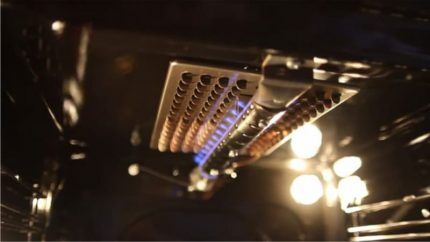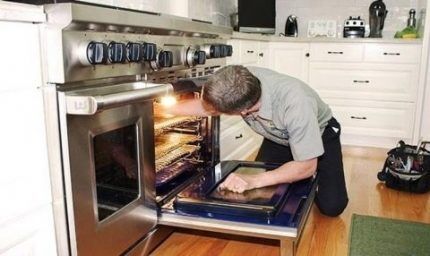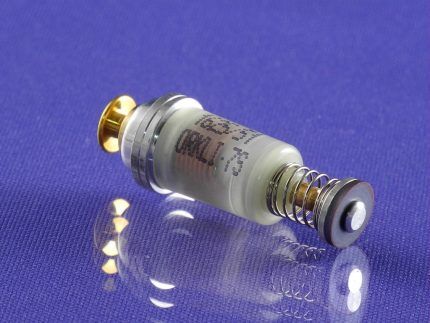How to turn on the oven in a gas stove: recommendations for igniting gas in the oven and an overview of safety rules
A gas stove is a completely familiar and understandable device.However, its use may raise certain questions. So, the housewife may not understand how to turn on the oven in a gas stove if the owner has not previously encountered a specific model.
But dishes cooked in the oven usually turn out to be much tastier than those cooked on the hob, and retain more useful elements. Therefore, it’s worth learning how to start the oven once, so that you can easily pamper your household with mouth-watering culinary masterpieces of any complexity. Do you agree?
In this material we will understand the principles of operation of gas ovens, talk about ways to ignite a flame in them and the safety precautions that must be observed when operating such equipment. We will supplement the material with visual photos and thematic video recommendations.
The content of the article:
The principle of operation of a gas oven
Understanding exactly how a gas oven works, it is much easier to properly light a fire in it. If the hob burner directly heats the bottom of the pan and diffusely heats the limited space around it, then the oven builds up the desired temperature in the isolated space. Heating of the air that participates in heat treatment often occurs from below, after which the hot streams evenly rise upward, circulating inside the oven.
The oven has its own separate burner in which the gas-air mixture burns.Burners are most often diffusion: the mixing of gas and air in them occurs naturally, without additional oxygen intake.
After opening the tap, the gas passes through the nozzle, combines with air and is ignited by a spark. The latter is formed due to electricity or open fire from a match or lighter.

If your oven is equipped convection, we recommend that you familiarize yourself with the features of enabling, using and disabling this mode.
Ways to light a fire in the oven
Ignition of the flame can be carried out in two ways, which directly depend on the functional features of the equipment model itself. It depends on them how correctly the housewife can light the gas oven in her kitchen.
The methods for lighting a fire in the oven are as follows:
- Electric ignition oven is characteristic of many modifications and is more convenient and safer, since it does not imply direct human contact with the burner.
- Manual ignition flame requires some skill. But models of stoves or ovens with a similar principle of igniting fire usually cost slightly less.
The algorithm for operating different ovens will be slightly different. Let's consider the features of use in more detail.
Method #1 - electric ignition of the oven
Turning on the oven using automatic ignition is quite easy and quick.
To do this you just need to take a few simple steps:
- turn the gas supply tap, setting it to maximum;
- press and do not release the electric ignition button;
- after the flame appears, release the ignition button after 5-10 seconds.
If after these manipulations the fire does not light or the burner does not work correctly, you need to stop the fuel supply and open the oven door for ventilation. After a couple of minutes, you need to try to ignite again.

The need to hold down the auto-ignition button lies in the oven's safety system. The gas control sensor needs a certain temperature and time to properly monitor the operation of the equipment.
Additionally, holding is intended to protect the device from producing unwanted sparks if the button is pressed accidentally. After briefly pressing this button, you can set the temperature level required for cooking a specific dish.
Method #2 - manually starting the flame
You can also light the gas in the oven manually. Even if the cabinet is equipped with electric ignition, situations may arise when this option will not work. Therefore, even owners of modern technological models should understand how to light an oven in a gas stove with matches.
The process looks like this step by step:
- ventilate the oven for a few minutes and locate the pilot hole;
- bring a burning match or lighter to the igniter;
- turn the gas supply relay and hold it until the flame flares up;
- after ignition, do not release the feed handle for 15 seconds so that the security system responds correctly to turning on the oven;
- If the flame in the burner is produced stably, without separation or sparks, you can close the door and warm up the cabinet for subsequent cooking.
To find the igniter window, carefully inspect the bottom and sides of the oven when it is turned off. Most often, the required hole is located at the bottom of the cabinet or on its walls. If the oven is equipped with a gas grill, you should look for its burner on top.

For ignition, it is better to use long fireplace matches or a special lighter with an extended nozzle. This will protect your hands from burns and maximize the distance between the burner pilot and your hand.
Safety precautions when lighting the oven
No matter how you light the flame in the oven, you should always follow specific safety rules. Interacting with gas is always a risk, so you should be extremely careful to eliminate the likelihood of an emergency.
Next, let's look at the basic rules for safely igniting the oven:
- Before turning on a gas oven, always ventilate it to free the space from possible gas accumulation.
- Inspect the hoses, periodically check the tightness of their connections, and if necessary replace the worn one with a new one.
- Make sure the oven burner is fully ignited. If any section does not burn, turn off the gas supply, ventilate the cabinet and relight the flame.
- Never leave a working oven unattended, and remember to check for flames through the cabinet door window.
- Never use the oven while it is on as a heating source. You cannot heat the kitchen using air heated by a burner.
- Thoroughly clean all surfaces inside the oven after each cooking. Grease deposits and other contaminants can clog the igniter holes or the burner itself, which will cause the flame to burn unevenly or be completely absent during subsequent operation.
Gas smell or sound alert leak sensor – an alarm signal in which it is prohibited to use the equipment. Ventilate the room and, if possible, find the source of the fuel leak.

It is always worth monitoring the operation of potentially dangerous equipment. Incorrect functioning of any elements should raise alarm bells and become a reason to call a specialist from gas service to conduct an inspection, diagnose the problem and fix it.
Typical gas oven malfunctions
Even with careful use and proper ignition, the flame in the oven burner may be unstable or disappear completely. These common problems have very specific causes and are fairly easy to fix.
If the flame in the oven ignites without problems, but often goes out after some time, the reason can be sought in the operation of the gas control system. Most likely, its sensor is faulty or dirty, and therefore does not respond to ignition correctly, sending a signal to shut off the gas supply.
In the same situation, problem nodes may turn out to be thermocouple and a solenoid valve for a gas stove. The latter does not receive enough voltage due to a breakdown of the flame control sensor and automatically shuts off the supply of blue fuel.

In addition to malfunctions of specific parts, the cause of the flame going out after heating the oven may be an incorrectly adjusted minimum flame level. After maximum heating, the burner goes into gentle mode. If it does not meet the required parameters, the thermocouple will not warm up enough, which is why the device turns off.
If the gas burner in the oven does not turn on at all, the primary diagnosis will be to identify blockages in its openings, which may form due to carbon deposits or food debris, or contamination of the gas nozzle itself. If there are no deposits interfering with ignition, the structural parts are probably worn out and require replacement.
The gas tap as a separate unit can also influence the incorrect functioning of the burner in the oven. Any link in the design of the internal rotating mechanism may be damaged. Often this part cannot be repaired and must be completely replaced.
Conclusions and useful video on the topic
What the pilot hole in a gas oven looks like and where it is located is described in the video below. Additionally, the video shows how to remove the protective plate and gain access to the burner.
Information on how to light a flame in an oven without electric ignition with gas control in the following video:
As with any gas equipment, working with the oven must be extremely careful.Pay attention to any alarming dysfunctions of the device and contact specialists in time to avoid emergency situations..
And lighting a flame in a gas oven is quite simple: you only need to learn how to do it correctly once, after which the hostess will not need any outside help.
Would you like to supplement the information presented with useful recommendations or comments? Or do you still have questions that we did not cover in this material? Ask them to our experts and other site visitors - the feedback form is located below.



